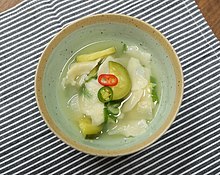Sujebi
 |
|
| Alternative names | Hand-pulled dough soup |
|---|---|
| Place of origin | Korea |
| |
|
| Korean name (South Korea) | |
| Hangul | 수제비 |
|---|---|
| Revised Romanization | sujebi |
| McCune–Reischauer | sujebi |
| IPA | [su.dʑe.bi] |
| Korean name (North Korea) | |
| Chosŏn'gŭl | 뜨더국 |
|---|---|
| McCune–Reischauer | ttŭdŏ-guk |
| IPA | [t͈ɯ.dʌ.ɡuk̚] |
Sujebi (수제비, in S. Korea), ttŭdŏ-guk (뜨더국, in N. Korea), or hand-pulled dough soup is a Korean traditional soup consisting of dough flakes roughly torn by hand, with various vegetables. The flavor and recipe resemble kalguksu, except that the latter is made with noodles rather than wheat flakes. It is commonly considered a dish to consume on rainy days, along with bindaetteok.
The broth for sujebi is usually made with dried anchovies, shellfish, and kelp. In order to obtain a rich, umami flavor, the ingredients should be simmered for many hours. Added to this broth are soft noodles and various vegetables or kimchi, most often zucchini and potatoes.
Korean people began to eat sujebi and guksu (국수 noodles), both dishes made of wheat flour, from the early Goryeo period (935~1392), but the name sujebi (earlier sujeop-eo) dates from the mid Joseon period. Sujeop-eo is a combined hanja word comprising the terms su (hanja: ; hangul: 수; literally "hand") and jeop (hanja: ; hangul: 접어 or 접다; literally "folded" or "folding").
From the Joseon period, people started making various types of sujeobi according to various purposes. Sujebi is today considered a typical commoner's food, but in the past, it was relatively rare and used for special occasions especially janchi (잔치; feast, banquet) such as dol janchi (the celebration of a baby's first birthday).
In North Korea, sujebi is called milgaru ddeudeo guk (밀가루뜨더국), which is the words comprising three words: milgaru (밀가루; literally "wheat flour") + ddeudeo (뜯어; literally "tearing" or "torn") guk (국; literally "soup").
...
Wikipedia
